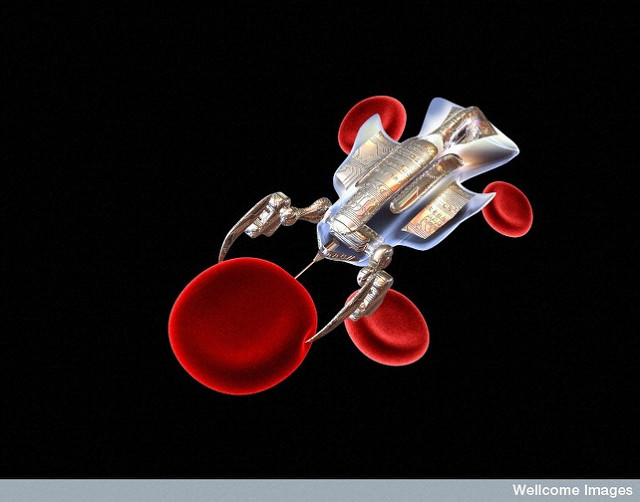Sylvain Martel of the NanoRobotics Laboratory at Polytechnique Montreal has spent the last 15 years discovering that just as you figure out what you need to design, it often comes about that it’s already been designed. At least, something else already exists with those exact specifications – it’s just being used for a different purpose. He’s been working on cancer, which in Canada is the number one cause of death. Canada is also – for now—the only place where medical nanorobots are a going concern.
In 2001, there were some very specific nanobots Martel wanted to build. They had to get a cancer drug from A to B. To get a therapeutic agent from an injection site to a tumour, systemic drugs are supremely inefficient. Only about 1% of the drug gets to the tumour, and 99% just drifts out of control and contributes to the patient’s decline. You can’t inject it directly into the area of maximum therapeutic effect, because the pressure of the injection will spread the cancer and help it to metastasize.
So Martel’s nanorobots had some very demanding specifications. They had to be able to travel with a little encapsulated payload of drugs through the leaky blood vessels—2 micrometers in diameter—that the tumour grows to sustain itself. They had to have a propulsion system to take them through the blood vessels and past the necrotic region where the cancer is already dead. They had to have a navigation system and steering to make sure they went the right way. They had to have some sort of power source. And they had to have an oxygen sensor that could tell when environmental oxygen levels had dropped to 0.5% oxygen, where the heart of the tumour was guzzling blood – the source of metastasis.
Oh, and lastly, the nanorobots would have to be self-replicating, because there would have to be 100 million of them in each injection.
“So we went shopping in nature, and we found this MC-1 bacteria. We stole it and made it better over the years,” says Martel.
The bacterium is normally found in the ocean, where it survives in a low-oxygen environment. Smaller than a red blood cell, it uses the Earth’s magnetic field to orient itself and travel deeper into the ocean until its oxygen sensors detect – bizarrely – the exact 0.5% oxygen saturation Martel requires. It can travel 300 body-lengths per second, which works out to about 10cm, and its population doubles every two hours. After 30 minutes it dies, and after 24 hours it is gone from the body. In other words, just as Martel thinks of another spec he needs, this bacterium seems to meet it.
“Various sensors or taxes in bacteria influencing their movements can be exploited to perform tasks that were previously considered only for futuristic artificial microrobots,” reads one of the team’s abstracts from 2012.
The next task was to get the little germs to swim where Martel wanted them to go, and then to make it over the ultimate drug hurdle – the blood-brain barrier. He bought a second-hand MRI machine. Not for scanning, mind you, but as a drug delivery system. Using the magnet in the MRI he created an artificial magnetic North to direct the little bio-bots, exploiting their internal magnetic guidance system. Now they can push things or pull them, swim forward or backward and build little nano-pyramids of stuff. Once they get near a tumour, they disappear on their own into the anoxic zone, carrying drugs.
After years of experimentation, Martel’s team discovered that they could penetrate the blood-brain barrier by taking advantage of the unique physics that happens on a nanoscale. Rapidly flipping the magnetic field 100,000 times effected a small local temperature increase that carried the bots through the membrane.
With primate trials still on the horizon, who knows how this research will touch our day-to-day lives. It’s far too early to tell. Maybe this will turn out to be an overly-engineering-focused approach, and maybe it’s just the breakthrough we’ll need. But for now, the microbiologists in Martel’s lab are the only ones who know how to cultivate this bacteria. “I tell them to be careful crossing the street,” he says.
Image: Wellcome images
